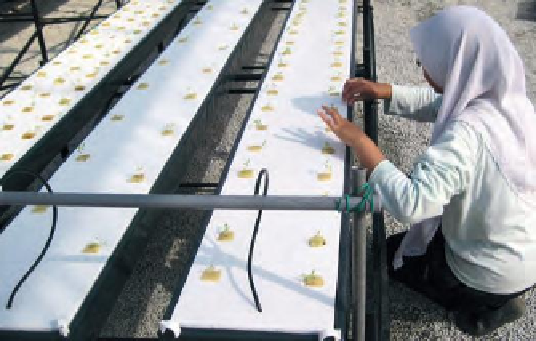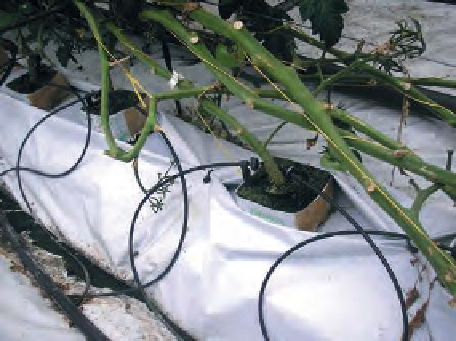Agriculture Reference
In-Depth Information
(a)
(b)
Figure 15.5
Hydroponic root media: (a) rockwool modules which are designed to receive the small plants and then at the
appropriate stage the block is moved into or on to rockwool slabs; (b) aggregate clay granules are used to fi ll gullies and
other containers
15
(b)
(a)
Figure 15.6
Hydroponic growing systems: (a) rockwool as polythene-wrapped slabs; (b) perlite in 'bolsters'
water was too difficult to maintain where the quality
of water was poor. It was found that the surplus
nutrient solution was most easily managed by
allowing it to run to waste into the soil. However, this
open system presents environmental problems and
increasingly a closed system has had to be adopted.
It is now becoming more usual to run the waste to a
storage sump via collection gullies or pipes. Some of
this can be used to irrigate outdoor crops if nearby.
To recirculate the water it is necessary to have
equipment to remove the excess fertilizer or accept a
gradual deterioration of the nutrient solution. It is then
flushed out to a sump when it becomes unacceptable.
There was also a risk of a build-up of water-borne
pathogens and trace elements. Sources of infection
such as
Pythium
(see p. 254) are minimized by
isolation from soil and using clean water; the risk of
recirculating pathogens is addressed by sterilizing the
water.
Rockwool is not biodegradable, so the vast quantity
now produced has created a serious disposal problem.
The slabs can be used successfully several times, if
sterilized on each occasion, but eventually they lose
their structure. Tearing them up and incorporating in
composts or soils can deal with a limited amount. Far
more can now be recycled in the production of new
slabs. Increasingly, the mineral aggregate is being
replaced by biodegradable materials processed to
provide a suitable root environment for hydroponics,
such as coir and green waste.
Expanded clay aggregates
such as Leca or Hortag
are made from processed clay which is heated and
then expanded in a rotary kiln. After finishing at a
very high temperature, sterile, tough, lightweight,
honeycombed balls with a smooth surface finish
are created. Granules 4-8 mm in diameter, giving
a
capillary rise
of about 100 mm can be used to
create a good root environment. They are non-toxic,
environmentally inert and are used in hydroponic
growing systems. They have an attractive dry
surface making them useful in decorative containers
(Figure 15.7).





